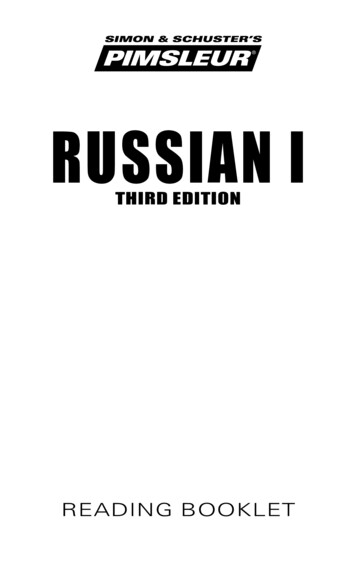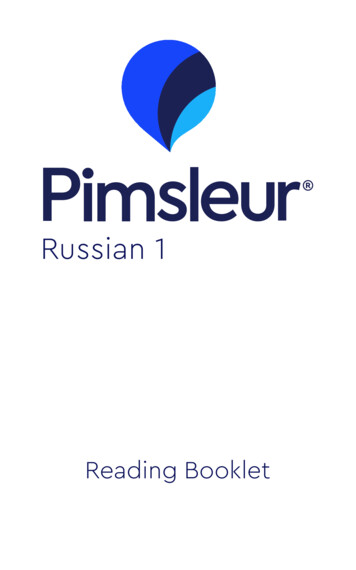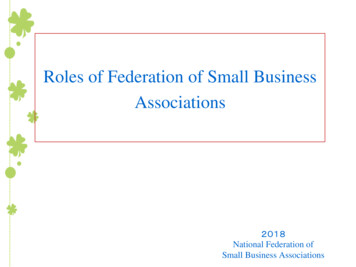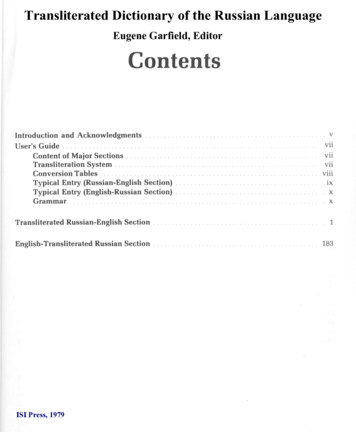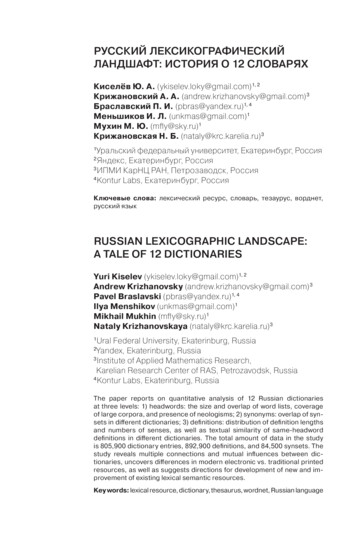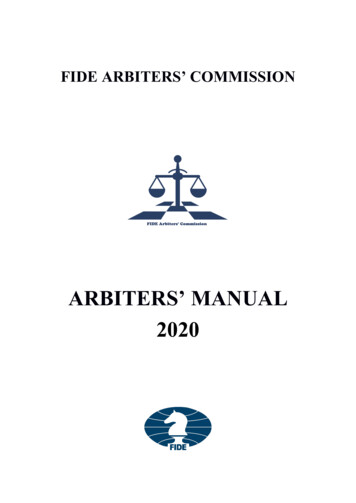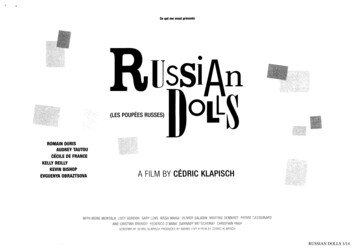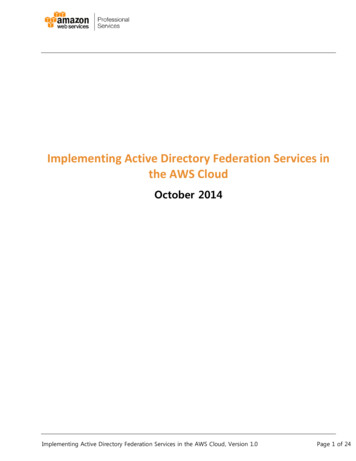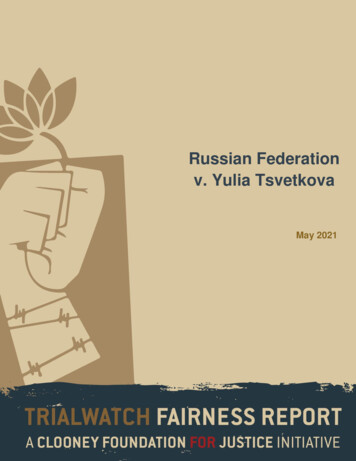
Transcription
Russian Federationv. Yulia TsvetkovaMay 2021Jun
ABOUT THE AUTHORHuman Rights Embassy is an international human rights nongovernmental organizationbased in Moldova and operating throughout the countries of the former Soviet Union andEurope. The organization’s mission is to contribute to the promotion of and respect forhuman rights worldwide. To achieve this goal, Human Rights Embassy undertakesprofessional development trainings of judges, prosecutors, lawyers, and police officers;human rights trainings for NGOs and mass-media; trial monitoring; strategic litigation;solidarity campaigns for the protection of human rights lawyers/defenders; awarenessraising campaigns; and advocacy.ABOUT THE CLOONEY FOUNDATION FOR JUSTICE’STRIALWATCH INITIATIVEThe Clooney Foundation for Justice's TrialWatch initiative is focused on monitoringand responding to trials around the world that pose a high risk of human rights violations.TrialWatch is global in scope and focused on trials targeting journalists, LGBTQ persons,women and girls, minorities, and human rights defenders. It works to expose injustice andrally support to secure justice for defendants whose rights have been violated.The legal assessment and conclusions expressed in this reportare those of the author and not necessarily those of the ClooneyFoundation for Justice.1
EXECUTIVE SUMMARYHuman Rights Embassy is monitoring the criminal prosecution of artist and human rightsactivist Yulia Tsvetkova in the Far East of the Russian Federation as part of the ClooneyFoundation for Justice’s TrialWatch initiative. Tsvetkova faces up to six years in prisonunder Article 242 of the Russian Criminal Code, which prohibits the dissemination ofpornography to minors over the Internet. While the Central District Court of Komsomolskon-Amur has closed the proceedings, this decision is inconsistent with Tsvetkova’s rightto a public trial.The trial comes after more than seventeen months of investigation, four of whichTsvetkova spent under house arrest. The criminal charges stem from Tsvetkova’s postingof drawings of female genitalia (in a series called "A woman is not a doll”) on a socialmedia page she administered entitled “Vagina Monologues.” The drawings were part ofa body-positive women’s empowerment campaign.Tsvetkova’s trial, which started on April 12, has been closed to the public. According tocredible sources, the court has justified this decision based on the “pornographic” natureof the images as well as on the presence of minor victims. The decision to close the trialhas not been made public.The right to a public trial is guaranteed by Article 14 of the International Covenant on Civiland Political Rights (ICCPR) and Article 6 of the European Convention on Human Rightsand Fundamental Freedoms (ECHR). Russia is party to both treaties.In accordance with the right to a public trial, any closure of criminal proceedings must bestrictly necessary, balancing the right of an accused to public scrutiny of his or her trialand the protection against potential abuse that such scrutiny entails with thecountervailing interest at issue. In the present case, it does not appear that the imagesposted on the “Vagina Monologues” page, which are not violent, do not feature minors,do not feature real individuals, and do not depict degrading treatment, justify closing thetrial on the basis of public morals.Further, the victims listed in the indictment – individuals who viewed the page when theywere minors – are no longer minors and, in any event, it is unclear how testifying publiclyabout having viewed the “Vagina Monologues” page would cause such individuals harm.As such, the protection of juvenile interests is inapposite.Even if the court decides that either the public morals or juvenile persons exceptionapplies, there can be no justification for closing the entirety of the trial. International andregional standards require that courts close only the portions of a trial necessary to protectwhatever public interest has been invoked. In this case, the court could examine certainwitnesses and evidence in camera and hold the remainder of hearings in public.2
As such, in order to comply with its obligations under the ICCPR and ECHR, at theupcoming hearing on May 24 the Central District Court of Komsomolsk-on-Amur shouldgrant the defense’s petition to open the proceedings or, at the very least, should closeonly certain portions of the trial to the general public.3
BACKGROUNDA. ACTIVISM AND CRIMINAL CHARGESYulia Tsvetkova is a 27 year-old LGBTQ and women’s rights activist from Komsomolskon-Amur, in the Far East of the Russian Federation. Among other things, Tsvetkova hasdirected a youth theater that challenges gender stereotypes and has provided “inclusivesex education for LGBTQ adolescents.”1Over the past two years, Tsvetkova has been convicted of administrative offenses inconnection with her activism.2 Specifically, on December 11, 2019, Tsvetkova was foundguilty of “propaganda of non-traditional sexual relations among minors,” an administrativeoffence under Article 6.21 of the Russian Code of Administrative Offences, and fined50,000 Rubles (US 780) for administering two LGBTQ-themed online communities onVKontakte, a popular Russian social media network.3 Both online communities had themarking “18 ,” in compliance with Russian law.4 On July 10, 2020 she was againconvicted under Article 6.21 for posting a drawing with the caption “Family is where loveis. Support LGBT families” on social media.5 The drawing, which depicted two samesex couples with children, was published in support of a same-sex couple who fled Russiawith their adopted children out of fear that the children would be taken by the State. 6According to Amnesty International, on July 7, 2020 the authorities initiated a thirdadministrative case against Tsvetkova pursuant to Article 6.21.7Tsvetkova is currently facing trial under Article 242 of the Russian Criminal Code for thealleged distribution of pornographic materials to minors through the internet.Article 242 reads in pertinent part:2. Distribution, public demonstration or advertising ofpornographic materials or objects among minors orinvolvement of a minor in the circulation of pornographicproducts committed by a person who has reached the age ofeighteen [is prohibited]1Indictment, Investigation Department Khabarovsk Krai, January 24, 2021, pgs. 5-6.See Amnesty International, “Russian Federation: Further information: Activist to stand trial for 598/2021/en/; Euronews, “Russian feminist artist on trialfor alleged 'pornography’”, April 12, 2021. Available at t-artist-on-trial-for-alleged-pornography.3 Id.4 Amnesty International, “Russian Federation: Further information: Activist to stand trial for her drawings:Yulia Tsvetkova”, January 29, 2021.5 Id.6 See id.7 Id.42
3. The deeds provided for by Parts One or Two of this articlecommitted by:b) using mass media, including information andtelecommunications networks (including the Internet)- shall be punished by imprisonment for a term of two to sixyears with or without deprivation of the right to hold certainpositions or engage in certain activities for a term of up tofifteen years.8The charges under Article 242 stem from drawings of vaginas that Tsvetkova posted in2018 and 2019 on a feminist page she administered on VKontakte entitled “VaginaMonologues.”9 Tsvetkova has described the drawings as “artistic images of femalegenitals.”10 As detailed by the Moscow Times, the posts were part of a series called “Awoman is not a doll," which aimed to challenge the objectification of women’s bodies, andto destigmatize female genitalia.11 Each image was accompanied by a written captiondescribing women with “hair on their bodies,” “fat,” and "wrinkles.” All of the captions endwith the statement: “And that's normal!”12In reference to this series, the indictment states that Tsvetkova “deliberately and illegallydistribut[ed] pornographic materials and publicly show[ed] them on the Internet, includingamong persons who have not reached the age of majority in free access for anunlimited number of people of different age categories [such] cynical naturalisticimages of female genital organs depicted there [are] deeply contrary to ethical standardsand moral principles.”13 The “Vagina Monologues” VKontakte page currently contains an18 disclaimer.14The indictment outlines various criteria employed by one of the prosecution’s experts todetermine whether the images in question could be characterized as pornography. Thecriteria mentioned include:The representation of “the sexual sphere of a personimpersonally, focusing on the female genitalia”;The simplification of “the meaning and significance ofthe human sexual sphere,” in particular by reducing “the ideaof human sexuality and the idea of female genitalia (‘vagina’)to being an exclusive source of bodily pleasure, while 7477.9 See Indictment, Investigation Department Khabarovsk Krai, January 24, 2021.10 Id. at pg. 7.11 AFP/The Moscow Times, “Russian Feminist Activist Goes on Trial for 'Body-Positive' Drawings”, April12, 2021. Available at rawings-a73560.12 Id.13 Indictment, Investigation Department Khabarovsk Krai, January 24, 2021, pg. 2.14 See “Vagina Monologues” (Монологи Вагины). Available at https://vk.com/public168504579.5
the topic of heterosexual relationships, pregnancy, childbirth,family relationships”;The imposition of “erroneous ideas about the sexualsphere of a person,” involving “a stereotype of femalesexuality as an isolated phenomenon that exists outside ofsexual relations with men”;The “stimulat[ion] of the sexual interest and sexualarousal of visitors”;“Dehumanization ignoring the individual andpersonal characteristics of a woman”;“[I]nstrumental manipulation” through promotion of“the idea of ‘removing the stigma from the vagina and femalephysiology in general’ through exaggerated distortingaestheticization of female sexuality”;Dissemination of the “author's ideas about theimaginary danger of stigmatizing women on the basis ofgender”; andThe drawing of attention to “the female genital organ,stimulating sexual interest outside of the context of thewoman's personality, of her life situation, of heterosexualromantic relationships and intimate emotional experiences”.15The indictment corroborates Tsvetkova’s own statements that the drawings wereintended to destigmatize the female body: according to the indictment, Tsvetkova“believed” that such renderings were “the norm, promoting such images and therebyencouraging the public to introduce them into ordinary use.” 16 The indictment lists asvictims several individuals who viewed the images when they were minors.B. PROCEDURAL HISTORYThe criminal case against Tsvetkova stemmed from complaints filed by Timur Bulatov,17an anti-LGBTQ activist who heads organizations such as the “First Moral RussianFront.”18 Bulatov has been described as “routinely troll[ing] members of the gaycommunity online,” and has campaigned for children to be removed from gay couplesand for the dismissal of schoolteachers perceived as gay. 19 Bulatov reported Tsvetkovato the police after viewing the “Vagina Monologues” page, deeming the images featuredto be pornographic and “damag[ing] to the psychological and mental development of15Id. at pg. 13.Id. at pg. 2.17 Id. at pgs. 4, 6.18 BBC News, “Anti-gay campaign drives out Russian teacher in Krasnoyarsk”, December 22, 2016.Available at https://www.bbc.com/news/world-europe-38403923.19 Radio Free Europe/Radio Liberty, “A Grim Death, A Confession -- But No Closure in Russian LGBTActivist's Killing”, September 18, 2019. Available at re-convinced/30171342.html.616
minors.”20 Notably, Bulatov previously filed several complaints against Tsvetkova in 2019in connection with her alleged “promot[ion of] a homosexual lifestyle among adolescents,”involvement with the aforementioned youth theater group, and activity on VKontakte. 21The criminal case was formally initiated by the Komsomolsk-on-Amur police departmenton October 24, 2019.22 Tsvetkova was subsequently detained on November 20, 2019and put under house arrest two days later.23 She was released from house arrest onMarch 16, 2020, subject to travel restrictions.24 Since 2019, police investigators have filedseveral indictments against Tsvetkova, with the prosecution “return[ing] three of theseindictments for further investigation.”25 The most recent indictment was submitted by theinvestigative committee on January 24, 2021 and approved by the deputy prosecutor ofKhabarovsk Krai on February 8, 2021.26At a preliminary hearing on March 31, 2021, the Central District Court of Komsomolskon-Amur decided to close the proceedings. The order closing the trial has not been madepublic, but, according to credible sources, the decision was based on the “pornographic”nature of the images and the presence of minor victims. 27 The trial opened on April 12,2021. The first hearing in the trial addressed a motion to change the judge and theaddition of two defense lawyers, while the second hearing, on May 6, commenced theprosecution’s presentation of witnesses.On May 24, the court will address outstanding procedural requests, including a defensepetition to open the proceedings to the public.20Indictment, Investigation Department Khabarovsk Krai, January 24, 2021, pgs. 4-5.Id. at pgs. 5-6.22 Id. at pg. 6.23 Amnesty International, “Russian Federation: Activist Faces Jail for Female Body Drawings”, September2, 2020. Available at 772020ENGLISH.pdf.24 See Human Rights Watch, “Joint Letter to Russia’s Prosecutor General on Unfounded Charges AgainstYulia Tsvetkova”, March 5, 2021. Available at -yulia-tsvetkova.25 Id. See also Indictment, Investigation Department Khabarovsk Krai, January 24, 2021.26 Indictment, Investigation Department Khabarovsk Krai, January 24, 2021.27 See Amnesty International, “Russia: Feminist activist Yulia Tsvetkova’s absurd ‘pornography’ trial starts”,April 9, 2021. Available at graphy-trial-starts/.721
ANALYSISRIGHT TO A PUBLIC TRIALOverarching StandardsThe right to a public trial is guaranteed by Articles 14 and 6 of the ICCPR and the ECHR,respectively. Article 14(1) of the ICCPR states, in pertinent part:In the determination of any criminal charge against him, or ofhis rights and obligations in a suit at law, everyone shall beentitled to a fair and public hearing by a competent,independent and impartial tribunal established by law.Article 6(1) of the ECHR similarly entitles accused persons to “a fair and public hearingwithin a reasonable time by an independent and impartial tribunal established by law.”Public hearings help ensure the integrity of the judicial process, protecting againstpotential abuse of a defendant’s rights. In addition to safeguarding the rights of anaccused, the right to public hearings reflects the public’s right to understand and monitorhow justice is administered.As stated by the European Court of Human Rights:[T]he holding of court hearings in public . . . protects litigantsagainst the administration of justice in secret with no publicscrutiny; it is also one of the means whereby confidence in thecourts can be maintained. By rendering the administration ofjustice transparent, publicity contributes to the achievement ofthe aim of Article 6 § 1, namely a fair trial, the guarantee ofwhich is one of the fundamental principles of any democraticsociety.28The right to a public trial is a qualified right. The ICCPR provides for exceptions based on“reasons of morals, public order (ordre public) or national security in a democratic society, orwhen the interest of the private lives of the parties so requires, or to the extent strictly necessaryin the opinion of the court in special circumstances where publicity would prejudice the interestsof justice.” Article 6(1) of the ECHR similarly provides that:the press and public may be excluded from all or part of thetrial in the interests of morals, public order or national security28European Court of Human Rights, Werner v Austria, App. No. 21835/93, November 24, 1997, para. 45.See also European Court of Human Rights, Axen v. Germany, App. No. 8273/78, December 8, 1983, para.25; European Court of Human Rights, Diennet v. France, App. No. 18160/91, September 26, 1995, para.33; European Court of Human Rights, Hummatov v. Azerbaijan, App. Nos. 9852/03 and 13413/04,November 29, 2007, para. 140.8
in a democratic society, where the interests of juveniles or theprotection of the private life of the parties so require, or to theextent strictly necessary in the opinion of the court in specialcircumstances where publicity would prejudice the interests ofjustice.As stated by both the United Nations Human Rights Committee and European Court,“holding proceedings, whether wholly or partly, in camera must be strictly required by thecircumstances of the case.”29 Thus, “before excluding the public from criminalproceedings, the national court must make a specific finding that exclusion is necessaryto protect a compelling governmental interest and must limit secrecy to the extentnecessary to preserve that interest.”30 In undertaking such a calculus, courts mustbalance the benefits of closing the proceedings with the potential damage to the rights ofan accused.31Correspondingly, as an alternative to closing the whole trial, courts must consider whetherclosing just part of the proceedings32 or other measures, such as “selective attendance,”would be sufficient.33 For example, in Yam v. the United Kingdom, the European Court –finding no violation of Article 6(1) – deemed it significant that an in camera order hadbeen “limited to the extent necessary to protect the interests at stake and applied only toa specific part of the applicant’s defence. The vast majority of the trial – and the whole ofthe prosecution’s positive case – was held in public.”34Public MoralsAs noted above, courts are permitted to close all or parts of a trial to protect public moralswhere strictly necessary. Because cases on the closure of legal proceedings inconnection with pornographic materials have infrequently come before the United Nations29See European Court of Human Rights, Welke and Bialek v. Poland, App. No. 15924/05, March 1, 2011,para 74; European Court of Human Rights, Martinie v. France, App. No. 58675/00, April 12, 2006, para 40;European Court of Human Rights, Yam v. the United Kingdom, App. No. 31295/11, January 16, 2020, para54. The Human Rights Committee has stated that the public may only be excluded from proceedings in“exceptional circumstances.” Human Rights Committee, General Comment No. 32, U.N. Doc.CCPR/C/GC/32, August 23, 2007, para. 29.30 European Court of Human Rights, Yam v. the United Kingdom, App. No. 31295/11, January 16, 2020,para 54; European Court of Human Rights, Belashev v. Russia, App. No. 28617/03, May 4, 2009, para 83.31 European Court of Human Rights, Belashev v. Russia, App. No. 28617/03, May 4, 2009, paras. 83-84;European Court of Human Rights, Yam v. the United Kingdom, App. No. 31295/11, January 16, 2020, para.57.32 See European Court of Human Rights, Belashev v. Russia, App. No. 28617/03, May 4, 2009, para. 84;European Court of Human Rights, Yam v. the United Kingdom, App. No. 31295/11, January 16, 2020, para.62.33 See European Court of Human Rights, T. v. United Kingdom, App. No. 24724/94, December 16, 1999,para. 85.34 European Court of Human Rights, Yam v. the United Kingdom, App. No. 31295/11, January 16, 2020,para. 62.9
Human Rights Committee and European Court of Human Rights,35 jurisprudence on othertypes of limitations placed on pornographic materials for the purposes of protecting publicmorals is instructive.In a case where an artist held an exhibition that featured images depicting adolescentsand young women in sexual positions or acts (with the goal of critiquing the accessibilityof child pornography), the European Court found that the closure of the exhibition andcriminal conviction of the artist did not violate her right to freedom of expression.36 TheCourt noted that the artist’s conviction was based on the need to “protect morals as wellas the reputation or rights of others.”37 Decisive factors appeared to be the “violent anddegrading” nature of the pictures and the fact that “the faces of many of the children oryoung women in the pictures were clearly recognisable and their reputation and right toprivate life had to be protected.”38With respect to sexually explicit materials, the United Nations Human Rights Committeehas likewise emphasized that restrictions are appropriate where images “portray[] womenand girls as objects of violence or degrading or inhuman treatment.”39Notably, in cases in which “policies and decisions embodied a predisposed bias onthe part of a heterosexual majority against a homosexual minority,” including whereauthorities act to prevent a supposedly “‘distorted image of the social equivalence oftraditional and non-traditional sexual relationships,’” the European Court has refused touphold restrictions on Convention rights on the basis of public morals.40In the present case, it does not appear that the closing of the trial can be justified on thebasis of public morals: in other words, on the basis of protecting the public from allegedlyobscene evidence or witness testimony that would be presented at trial. First, nowhere inthe indictment is it alleged that the images are violent. Second, the images do not featureminor individuals, let alone real individuals. Third, given that the images feature femalegenitalia, not mutual sexual acts, the women shown in the drawings are not the object ofdegrading treatment. Indeed, the images are part of a body-positivity campaign aimed atempowering women of all shapes and sizes.35In Muhammad Kaboudvand v. Islamic Republic of Iran, the United Nations Working Group on ArbitraryDetention ruled that the exclusion of the public from the trial of Mr. Kaboudvand in connection with hisreporting on prison conditions in Iran could not be justified on the basis of public morals. Working Group onArbitrary Detention, Muhammad Kaboudvand v. Islamic Republic of Iran, U.N. Doc.A/HRC/WGAD/2012/48, August 27, 2013, paras. 6-7, 21.36 European Court of Human Rights, Karttunen v. Finland, App. No. 1685/10, Inadmissibility Decision, May10, 2011.37 Id. at para. 22.38 Id. at paras. 3, 6. 23-24.39United Nations Human Rights Committee, General Comment No. 28, U.N. Doc.CCPR/C/21/Rev.1/Add.10, March 29, 2000, para 22.40 European Court of Human Rights, Bayev and Others v. Russia, App. Nos. 67667/09, 44092/12, &56717/12, November 13, 2017, paras. 67-71. See also Human Rights Committee, Fedotova v. RussianFederation, U.N. Doc. CCPR/C/106/D/1932/2010, November 30, 2012, paras. 10.4-10.8.10
Further the language of the indictment raises concerns that the images in question havebeen deemed obscene – and hence damaging to public morals – due to the perceptionthat they depict activity that is not heterosexual or, at the very least, non-traditional. Theindictment, for example, refers to an expert’s opinion that the materials were pornographicbecause of their purported reduction of “the idea of human sexuality and the idea offemale genitalia (‘vagina’) to being an exclusive source of bodily pleasure, while ignoringthe topic of heterosexual relationships, pregnancy, childbirth, family relationships” andtheir promotion of “erroneous ideas about the sexual sphere of a person,” involving “astereotype of female sexuality as an isolated phenomenon that exists outside of sexualrelations with men.” As established by the European Court, restrictions on the basis ofpublic morals that embody bias against members of the LGBTQ community or againstnon-traditional sexual relations cannot be justified.Protection of MinorsAs noted above, courts can exclude the public and/or press to protect the interests ofminors where strictly necessary. The United Nations Human Rights Committee andEuropean Court of Human Rights have declined to find violations of the right to a publictrial in certain cases where proceedings were closed to protect minors who weredefendants, victims, witnesses, or otherwise implicated. In B. and P. v. United Kingdom,for example, a court excluded the public from proceedings held to determine where minorchildren should live following a divorce. The European Court found that this decision didnot violate the parent’s right to a public trial given that, among other things, the hearingsinvolved discussion of the children’s private lives.41 In converse, in T. v. United Kingdom,the European Court found that in order to uphold the principle of a fair trial, the trial courtshould have closed the trial of an 11 year old for murder given the “feelings of intimidationand inhibition” engendered by public proceedings and the defendant’s “immaturity and disturbed emotional state.”42In the present case, the victims listed in the indictment who viewed the images as minorsno longer appear to be minors, meaning that their involvement in the proceedings wouldnot warrant the closure of trial on the basis of their underage status. Moreover, as notedabove, the images at issue were not violent, did not feature minor or even real individuals,and did not depict women as objects of degrading treatment. Without specification as tothe nature of potential harm, the basis for deeming public participation in the trial harmfulto minor victims and/or witnesses is unclear.41European Court of Human Rights, B. and P. v. United Kingdom, App. Nos. 36337/97 and 35974/97, April24, 2001, para. 38.42 See European Court of Human Rights, T. v. United Kingdom, App. No. 24724/94, December 16, 1999,paras. 85-89.11
Notably, the exclusion of the public on the basis of the protection of juvenile interestsdoes not permit the closure of trials on the basis that minors writ large might attend orread about the proceedings.Closing Only Part of the TrialAs discussed above, where courts must close proceedings to protect public interests,international and regional standards require that they do so only as strictly necessary,meaning that where possible only portions of the trial – not the entire trial— should beclosed. This is consistent with the need to balance public interests with an accused’s rightto a public trial and protection against potential abuse.In the present case, even if the court decided that there was a need to shield the publicfrom allegedly obscene materials or to protect the interests of juveniles, it would not benecessary to close the entire trial, but only certain hearings. Consequently, the sweepingclosure of the trial violates Tsvetkova’s right to publicity and transparency, particularlygiven that she is facing six years in prison.12
CONCLUSIONIn accordance with the International Covenant on Civil and Political Rights and theEuropean Convention on Human Rights and Fundamental Freedoms, the trial of YuliaTsvetkova should not be closed to the public or, at the very least, should only be closedin part. It is incumbent upon the court to comply with Russia’s treaty obligations andprotect Tsvetkova’s right to a fair trial.13
media page she administered entitled “Vagina Monologues.” The drawings were part of a body-positive women’s empowerment campaign. Tsvetkova’s trial, which started on April 12, has been closed to the public. According to credible sources, the court has j
![[MS-ADFSOD]: Active Directory Federation Services (AD FS .](/img/1/5bms-adfsod-5d.jpg)
